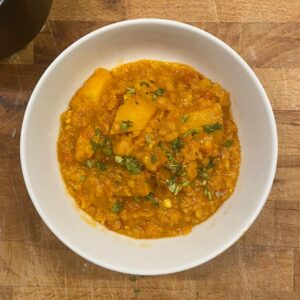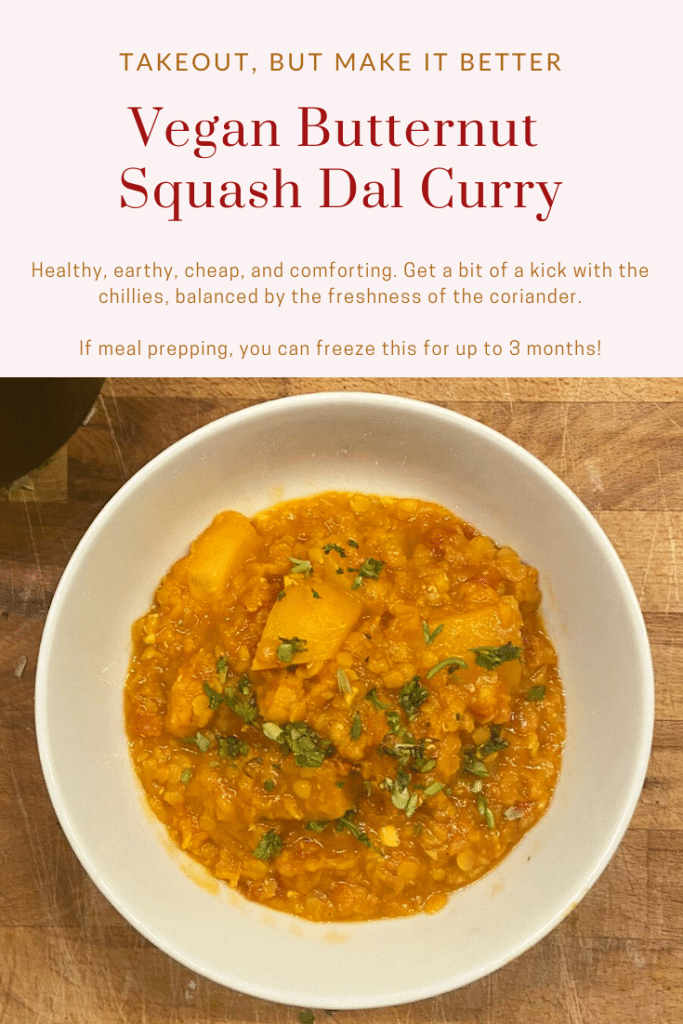Dicko’s Accidentally Vegan Butternut Squash Dal Curry
This butternut squash dal curry recipe calls for red lentils, known as masoor dal. Dal (also spelled dhal, daal, or dāl ) is the Hindi name for lentils and other so-called “split-pulses” like black-eyed peas and chickpeas. It also refers to the rich curry stews where these legumes feature. They are paired with butternut squash to form a (semi-authentic) take on a British-Indian classic, suitable for vegans. The added chilis give it a bit of bite. You can swap the squash for sweet potatoes as well.
This meal is a good contender for bulk-cooking meals a few days in advance. It will last a few days in the fridge and will freeze well too. It’s also healthy as hell, meaning you can eat a lot of it and not worry. It would go well with naan bread.
For tips on prepping the squash and tangential thoughts on curries and the concept of Indian cuisine, see my post-curry musings after the recipe.

Dicko’s Butternut Squash Dal Curry
Equipment
- Big ol' dutch oven
- Chef's Knife
- Microplane/grater (optional)
- Y-peeler (optional)
Ingredients
- 1 tbsp vegetable oil
- 1 medium yellow onion, finely diced
- 1-2 hot chillis (thai green, scotch bonnets, habanero, etc.), seeded and diced
- 1 thumb-sized knob ginger, finely grated/minced
- 4 cloves garlic, finely minced
- 1 tbsp tomato paste
- 1 400g can canned tomatoes (~14oz can)
- 5 cups vegetable stock (2.5 stock cubes, chicken stock works well too)
- 1 whole butternut squash, peeled and cut into bite sized cubes (see notes on how to prepare a butternut squash)
- 300 g red lentils (~1 cup)
- 1 ½ tsp cumin
- 1 tsp turmeric
- 1 tsp coriander powder
- 1 tsp garam masala
- ½ tsp extra spicy chilli powder
- 7 cardamom pods broken open and seeds pulverised
- coriander/cilantro, chopped to garnish
Instructions
- After you've mise en place'd everything (that means getting all your spices measured out, veggies cut, your kitchen prepped), heat up the vegetable oil over medium-low heat and when hot, add the onions. Cook for 5 mins until translucent and fragrant, stirring regularly. Throw in the spicy chillis. Cook for 3 mins. Add ginger and garlic and cook for 1 min.
- Add in the tomato paste and all the spices and stir them about until everything is coated in a rich and fragrant paste, about 1 min. Dump in the butternut squash. Stir everything around for 3 mins.
- Add the canned tomatoes and vegetable stock. Bring to a boil. Then back off the heat and let it simmer for 10 mins, stirring occasionally.
- Add the red lentils, stir them about and let them co-mingle with everything else. Simmer for an additional 20 mins, until squash is tender (the lentils shouldn't be mushy).
- Transfer to a bowl and decorate with the chopped coriander.
Post Butternut Squash Dal Curry Musings
How to prep a butternut squash
Butternut squash are pretty good, but they can be a pain to prep. You’ve got to peel it but it’s uneven, cutting through it is as unwieldy as cutting an avocado, and making uniform pieces can be a struggle. I was going to make a video but then realised there was already a good one out there at BBC Good Foods.
But if you just want a quick guide:
Make sure to use a larger, proper chef’s knife and make sure it’s sharp. If you have a smaller santoku as I do, the blade might be too short for the length of the squash and you might not make as strong of a cut and the squash may slip and you may find yourself with a gnarly injury.
Then:
- Cut the ends off
- Cut at the base of the squash, dividing the bulb from the neck
- Peel the two different sections; life will be easier if you use a Y-peeler, but if using a knife keep your palm on top of the squash
- Cut the bulbous bit in half and scoop out the seeds with a spoon
- Slice up the bulbous halves in wedges; then cube them; they should be mostly uniform
- For the neck-bit, shave off the sides to square it then cut them into cubes.
On Curries and Pretences to Authenticity

Having lived in Britain for a few years, aside from pubs, I’d say my favourite thing is going to a curry house for a chicken (or lamb) vindaloo. It’d be easy to think that these staples of British culture are also authentic representations of “Indian cuisine” given how ubiquitous they are on the British high street. But you’d be wrong.
Curries as we tend to know them are really more of a British-Indian thing rather than authentic representations of Southeast Asian cuisine. They are more suited to the palates of the British and might be better understood as a kind of metaphor or metonymy for the complex and messy colonial history Britain and the peoples of the Indian subcontinent share (to put it one way).
For starters, as I’ve come to learn, there is no “Indian cuisine”, given that the present-day subcontinent itself consists of numerous different countries (including India, Pakistan, Bangladesh, Sri Lanka, Bhutan, Nepal, and Maldives), many of which have different cultures, languages, and cuisines (India itself having over 20 languages and dozens of different ethnic groups).
Spiced stews and rich sauces comprise just a tiny percentage of the vast and wondrous array of food on that side of the world. This is to say that I’ve only scratched the surface of Southeast Asian food, and I feel it frankly easier to try and re-create their British incarnations.
This is why this is this butternut squash dal curry is my first published attempt, it’s not even authentic to British-Indian cuisine (which itself has a rich history).
I’ve decided upon a generic blend of “Indian” spices that don’t require any roasting or grinding, which is one of the hallmarks of both British-Indian and Southeast Asian cuisine. For instance, you may be interested to know that “garam masala” isn’t a specific spice but just refers to toasted spices like cumin seeds, coriander seeds, cinnamon, and cardamom blended together.
Still working on my restaurant chicken vindaloo, which I hope to perfect soon, but we also got our hands on a traditional recipe – we’ll get both of them ready for the next posts on Takeout, But Make It Better!
